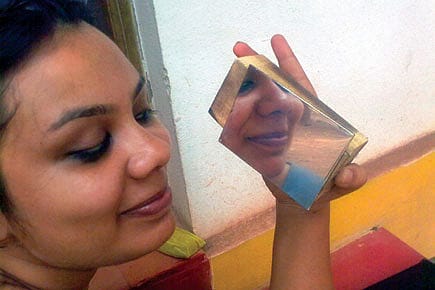The Daguerreotype’s Second Life

At a residency in Goa, a photographer is trying to revive the world's first widely publicised process of developing photographs
Although Vidisha Saini is a young photographer in her early 20s, there is an acute aching after antiquity that marks her work. Her first solo show, at Matthieu Foss Gallery, which features photographs from two series—Pratibimb and Showtime—documents archaic and dwindling art forms. The former is a set of portraits of Behrupiya performers, a group of nomadic lower caste communities in India, Pakistan and Bangladesh. These costumed street artists, who were once patronised by kings (and were rumoured to have made excellent spies), now live mostly in dire poverty. The latter is a set of portraits of circus artists sated in an air of comic sadness heightened by faded, garish outfits and props. Running through the photographs is a sense that these are slowly vanishing worlds, lost amid the din and colour of televised entertainment.
In addition to this, and even more interesting, is Saini's current residency at the Goa Centre for Alternative Photography, where she is working on a body of work using the Daguerreotype process. This is the first publicly announced photographic process developed in the 1830s by French artist and chemist Louis Daguerre and inventor Nicéphore Niépce. It cannot get more archaic than that.
Saini's penchant for the archaic extends to the technology she has used for past projects, including pin hole and toy cameras. She explains why—"Once you understand what you want to photograph, you should play around with these processes. Sometimes, the process you are using, the time you are spending on it, where you are making it, changes your final photograph from what you imagined it to be."
Lost: The Unstoppable Decline of Congress
05 Dec 2025 - Vol 04 | Issue 50
Serial defeats | Leadership in denial | Power struggles
The Daguerreotype process is one such experiment. Here, mercury vapour is used to develop the image on a copper plate, which has a light coating of silver previously sensitised to light with iodine vapour to form silver iodide crystals on the plate's surface. The process involves an exposure time of about half an hour, the idea being that the light has the effect of leaving behind a milky white image. The languid pace is precisely what Saini enjoys. "I wanted to get away from Delhi… the pace at how things happen in Goa is incredibly relaxing, similar to the pace of Daguerreotypes."
Considering we live in a world where digital photographs can be printed at the click of a button, and where PhotoShop has airbrushed away most photographer's problems, it is refreshing to hear that Saini has so far managed to create only two Daguerreotype prints. "I was supposed to be making a series of portraits with 'Dags', but here I am with more than twelve failed plates, because each step can change the way the plate works. Most of the Daguerreotypists, those who have been doing it for many years, also have only ten plates to share. When a friend came to know we were making Dags, she said, 'Either you are a hundred years late or ten years early.'"
While almost everyone now owns an SLR and has image-manipulating software on their computer, there is a certain charm and thrill to doing things the very old way. Saini says, "Due to it being an expensive, time-consuming and hazardous process, it may be that we are the only ones making Daguerreotypes in the world."
Pratibimb and Showtime will be on view at the Matthieu Foss Gallery in Mumbai till 15 May
